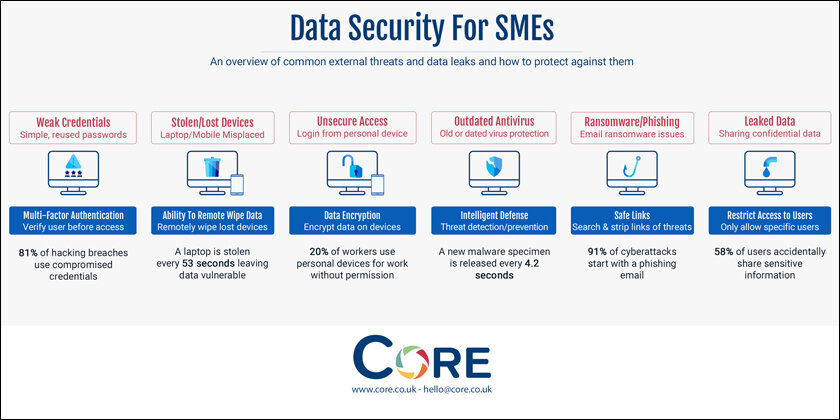Embark on your digital transformation journey with confidence by learning about the top cybersecurity pitfalls to avoid.
Introduction
Businesses are increasingly embarking on digital transformation journeys to stay relevant and competitive. This transformation, while crucial, exposes organizations to a plethora of cybersecurity risks. As companies digitize their processes, they inadvertently expand their attack surface, giving cybercriminals new vulnerabilities to exploit. Understanding and avoiding common cybersecurity pitfalls is essential to safeguard sensitive data and ensure a smooth transition into the digital age.
This blog post aims to shed light on the top seven cybersecurity pitfalls to avoid, providing valuable insights to help you protect your data and prevent threats during your digital transformation journey. Whether you’re in the early stages of digital transformation or looking to fortify your existing digital infrastructure, these insights will help you navigate the complexities of cybersecurity with greater confidence and effectiveness.
Understanding the Importance of Cybersecurity in Digital Transformation
Impact of digital transformation on businesses
Digital transformation is reshaping businesses by integrating digital technology into all areas of an organization, fundamentally changing how they operate and deliver value to customers. It’s not merely about adopting new technologies but about revolutionizing business processes, enhancing customer experiences, and becoming more agile. As companies become increasingly digital, from cloud services to IoT devices, the attack surface for potential cyber threats expands. This shift necessitates a robust defensive mechanism against cyber threats, underscoring the critical role of cybersecurity in ensuring a secure and resilient digital transformation journey.
Role of cybersecurity in safeguarding digital assets
Cybersecurity plays a pivotal role in protecting the digital assets of a company, which includes everything from customer data to intellectual property. It involves deploying a combination of technologies, processes, and practices designed to protect networks, devices, and data from attack, damage, or unauthorized access.
In the context of digital transformation, cybersecurity ensures business continuity by mitigating risks associated with cyber threats, safeguarding data privacy, and maintaining customer trust. Effective cybersecurity measures not only prevent financial losses and legal repercussions but also uphold a company’s reputation, which is crucial in today’s digital economy.

Common Cybersecurity Pitfalls to Avoid During Digital Transformation
Lack of employee cybersecurity awareness
One of the significant pitfalls in cybersecurity is the lack of employee awareness. Employees are often the weakest link in the cybersecurity chain, as human error can lead to severe data breaches. Investing in regular and comprehensive cybersecurity training programs is essential to equip employees with the knowledge to identify and prevent potential cyber threats, such as phishing scams and social engineering attacks. Creating a culture of cybersecurity awareness throughout the organization is fundamental to safeguarding against cyber threats.
Neglecting regular software updates
Another common pitfall is the neglect of regular software updates. Software vendors frequently release updates and patches to address vulnerabilities that cybercriminals exploit. Failing to apply these updates promptly can leave systems exposed and at risk of being compromised. It is vital to implement a systematic approach for regularly updating and patching software across all digital platforms and devices to ensure the highest level of security and protection against emerging threats.
Insufficient data encryption measures
Insufficient data encryption measures can also pose a significant risk during digital transformation. Encryption is a critical component of data protection, serving as the last line of defense by rendering data unreadable to unauthorized users, even if they manage to breach other security measures. Businesses must employ strong encryption standards for both data at rest and in transit, ensuring that sensitive information remains confidential and secure. Additionally, adopting encryption technologies like SSL/TLS for websites and employing end-to-end encryption for communications can further enhance the security of digital assets.
Understanding and addressing these common cybersecurity pitfalls are crucial in navigating the complexities of digital transformation.
The Consequences of Ignoring Cybersecurity in Digital Transformation
The digital transformation journey is paving the way for innovative business models and operations. However, neglecting cybersecurity during this transformation can have devastating effects. Ignoring the critical aspect of security can lead to serious consequences, affecting not just the organization itself but its customers and partners as well.
Data breaches and their impact
A data breach is one of the most feared repercussions of inadequate cybersecurity. When sensitive information is accessed without authorization, it can lead to identity theft, financial fraud, and loss of customer trust. The impact extends beyond immediate financial loss, as companies must spend considerably on legal fees, regulatory fines, and measures to restore their system’s security.
Financial losses due to cyber attacks
Cyberattacks can drain an organization’s finances rapidly. Beyond the direct costs associated with responding to an attack-such as ransom payments, system repair, and increased security measures-there are significant indirect costs. These include business disruption, lost revenue due to downtime, and potentially increased insurance premiums. For many businesses, these financial burdens can be catastrophic.
Reputational damage from security incidents
Reputational damage is a long-term consequence of cybersecurity lapses. Once trust is broken, it can be exceedingly difficult to rebuild. Customers and partners may question the organization’s ability to protect their data, leading to lost business opportunities and a decline in customer loyalty and shareholder value.
Best Practices for Ensuring Cybersecurity in the Digital Transformation Journey
Securing the digital transformation journey requires a proactive approach. By adopting best practices, organizations can significantly reduce their risk of suffering a cybersecurity incident.
Implementing multi-factor authentication
Multi-factor authentication (MFA) adds an extra layer of security by requiring users to provide two or more verification factors to gain access to a resource. It effectively reduces the risk of unauthorized access, even if a password is compromised. Implementing MFA across all digital platforms is a fundamental step in enhancing security.
Conducting regular vulnerability assessments
Regular vulnerability assessments are crucial for identifying and addressing security weaknesses before they can be exploited. These assessments should be conducted periodically and following any significant changes to the organization’s digital infrastructure. By uncovering vulnerabilities early, companies can patch them promptly, reducing the window of opportunity for hackers.
Investing in cybersecurity training for employees
Employees often represent the first line of defense against cyber threats. Investing in comprehensive cybersecurity training equips them with the knowledge to recognize and respond to security incidents effectively. Training should cover topics such as phishing, safe internet practices, and the importance of strong password hygiene. Frequent updates and refresher sessions can help ensure that cybersecurity remains a top priority for everyone within the organization.
Understanding and addressing the potential consequences of insufficient cybersecurity, coupled with implementing best practices, are crucial steps in safeguarding the digital transformation journey. By doing so, organizations can achieve their innovative goals without compromising their security or integrity.
A Closer Look at Emerging Threats in the Digital Landscape
The digital transformation journey presents an expanded surface for cyber threats, introducing new vulnerabilities and amplifying the consequences of potential security breaches. Understanding these emerging threats is crucial for developing effective strategies to mitigate risks.
Social engineering attacks
Social engineering attacks exploit human psychology rather than technical hacking techniques, making them particularly challenging to defend against. These attacks, including phishing emails and pretexting, are becoming increasingly sophisticated. They often involve meticulously crafted messages or scenarios designed to manipulate individuals into divulging confidential information or granting access to restricted components of an organization’s digital infrastructure.
The surge in remote work has further exacerbated risks, as employees may be more susceptible to such tactics outside the traditional office environment. Educating staff about the hallmarks of social engineering and encouraging vigilance are paramount in combating such attacks.
Ransomware targeting digital transformation initiatives
Ransomware, a type of malware that encrypts an organization’s data and demands payment for its release, has evolved to specifically target digital transformation initiatives. Cybercriminals recognize the critical importance of these projects to business operations and leverage this to demand higher ransoms. The integration of new technologies and processes can introduce vulnerabilities, particularly if cybersecurity considerations are not embedded from the outset. These attacks can severely disrupt operations and lead to substantial financial losses, underlining the need for robust security measures that encompass both prevention and recovery strategies.
Leveraging Technology for Enhanced Data Protection and Threat Prevention
As threats evolve, technology offers potent tools to bolster cybersecurity defenses. Implementing cutting-edge solutions can significantly reduce the likelihood of successful attacks and minimize their impact.
Role of artificial intelligence in cybersecurity
Artificial intelligence (AI) is revolutionizing cybersecurity, providing capabilities far beyond the reach of traditional methods. AI-driven systems can analyze enormous volumes of data in real-time to identify patterns indicative of a cyber attack. This capacity for continuous learning allows AI to adapt to new threats as they emerge, offering a dynamic defense mechanism. AI can also automate routine cybersecurity tasks, freeing up human analysts to focus on more complex challenges. The predictive power of AI enables organizations to anticipate attacks before they occur, shifting from reactive to proactive cybersecurity postures.
Importance of real-time threat detection solutions
Real-time threat detection solutions are essential for identifying and neutralizing cyber threats before they can inflict significant damage. These technologies monitor network traffic, system logs, and user behavior continuously, using advanced analytics to distinguish between normal activities and potential security incidents. Early detection is critical, as it allows organizations to respond to threats swiftly, often mitigating or entirely avoiding adverse outcomes. The integration of real-time threat detection into an organization’s security infrastructure is a vital component of a comprehensive cybersecurity strategy, ensuring resilience in the face of evolving cyber threats.
Conclusion
Navigating the digital transformation journey is a critical step for businesses aiming to stay competitive and responsive in today’s fast-paced market. However, without the right cybersecurity measures in place, this journey can quickly become perilous. The pitfalls mentioned above underscore the need for proactive and comprehensive security strategies that encompass not just technology but also people and processes.
By staying informed and vigilant, organizations can avoid common cybersecurity mistakes, such as neglecting employee training, underestimating the importance of data backups, or failing to regularly update their security protocols. It’s also crucial to foster a culture of security within the organization, ensuring that every member understands their role in safeguarding the company’s digital assets.
While the path to digital transformation holds immense potential for growth and innovation, it’s vital to approach this journey with caution and care. By recognizing and steering clear of the seven cybersecurity pitfalls outlined, businesses can secure their digital transformation efforts, protect their data, and thrive in the digital age. Cybersecurity is not a one-time effort but a continuous process that is integral to the success of your digital transformation journey.
In case you missed:
- Top 5 Cloud Security Threats and How to Combat Them


